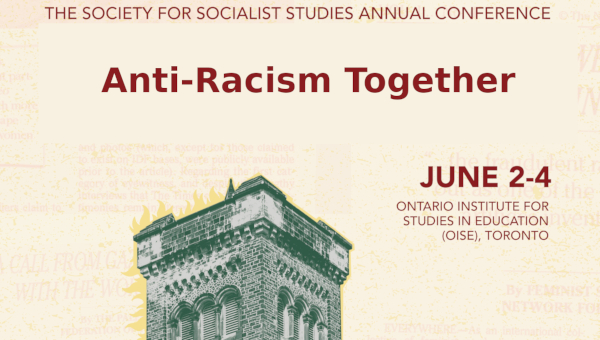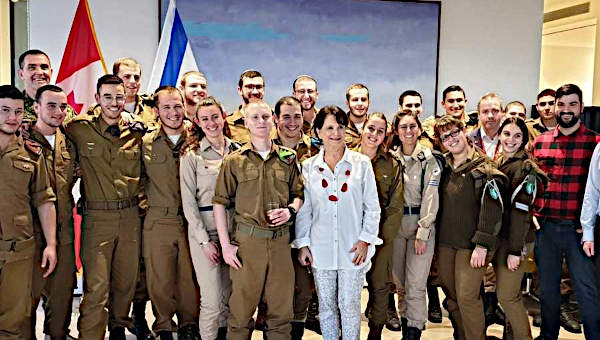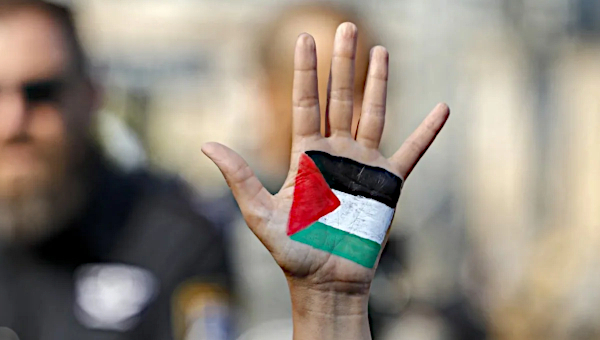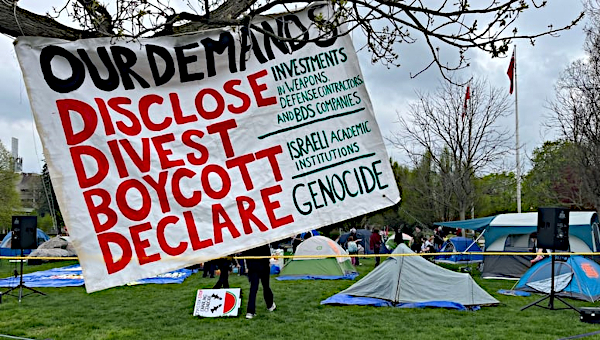Falling Into the pro-Israel Trap: The La Presse Cartoon Scandal
On 20 March, Montreal newspaper La Presse published a cartoon by Serge Chapleau harshly critical of Israeli Prime Minister Netanyahu’s announced intention to invade Rafah, where millions of Gazans are taking refuge. From across the globe, condemnations, even from political leaders, warn of the further deadly consequences of the attack, coming, as it does, after more than 30,000 Palestinians have been killed and even more starve.
The cartoon portrays Netanyahu in the iconic pose of Nosferatu, the vampire, from the 1922 German film by F.W. Murnau, aboard a ship bound for England, complete with the haunting lean face, the long fingernails, and the pointed ears, and the caption “Nosfenyahou, on the way to Rafah,” apparently to wreak more death and destruction.
Immediately and predictably, Jewish pro-Israel organizations like B’nai Brith and the Centre for Israel and Jewish Affairs (CIJA) denounced the cartoon as antisemitic. More specifically, they insisted that the pointed ears, the long fingernails, and the vampirism were tropes reminiscent of the infamous “blood libel” allegations by Christians in the Middle Ages, accusing Jews of draining Christian children’s blood to make ceremonial matzot.
Is the Nosfenyahou cartoon really antisemitic? Is it perhaps merely somewhat over-the-top, exaggerated, or impudent/imprudent? Or is it essentially innocent?
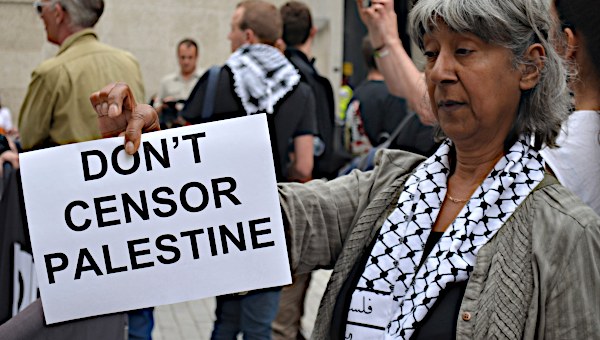
Criticism of Israel
Before attempting to answer this question, I need to get one thing straight. Overall, in my opinion, the purpose of attacks by pro-Israel organizations on academics, editorialists, cartoonists, medical students, protesters, and other assorted critics of Israel, before and after October 7, is to get everybody to shut up about Israeli atrocities. Practically speaking, that means moving the discourse Overton window on antisemitism as much to schtum as possible regarding negative comment on Israel.
This approach is epitomized in the International Holocaust Remembrance Alliance Working Definition of Antisemitism (IHRA-WDA,) wherein, of eleven examples of antisemitism, seven refer to criticism of Israel. Published in 2016, but now increasingly discredited, the IHRA-WDA has had a long head start and, strongly promoted by pro-Israel organizations, it is still being adopted by some legislatures, municipal councils, university administrations, and other institutions wishing to mollify criticism that they are not sensitive enough to the feelings of their Jewish populations.
But the IHRA definition is like a trap with a hair-trigger, meant to establish a stark and unrelenting binary (you’re either antisemitic or not), and accordingly snap shut on its prey the moment it crosses an impossibly low artificial line.
False accusations of antisemitism have mushroomed after the violent October 7, 2023, cross-border attack by Hamas on Israel and the subsequent Israeli war (which the International Court of Justice has decided is a “plausible genocide.”) Many critics of the Israeli response have been called out, cancelled, shut down, suspended, fired, punished, and doxxed. Let’s call it what it is: civil terror.
To name just a few of the shut-downs in Canada alone:
- Management at a Moxie’s restaurant in Toronto fired four employees for applauding passing marchers who disapproved of the killings in Gaza. Accusing the employees of antisemitism, B’nai Brith later claimed credit for the firings.
- CTV in Halifax fired a Palestinian non-broadcast employee after she criticized Israel outside of work hours; Global in Toronto fired a Palestinian on-air broadcast employee for similar activity.
- The University of Ottawa suspended Dr. Yipeng Gi, a Public Health medical resident after a Jewish colleague accused him of antisemitism for posting on social media support for the Palestinian cause.
- 271 Canadian medical students signed an open letter calling for a ceasefire in Gaza. Some doctors, claiming these students were antisemitic, organized a campaign to try to punish them by contacting residency coordinators to deprive the students of preferred specialties,
- The University of Manitoba suspended a nursing student and president of the nursing student council for alleged antisemitism after posts criticizing Israel appeared on her private social media
- At a Toronto rally against the Gaza killings, an acrobatic participant nicknamed “Spiderman” jumped on numerous light standards, hoardings, and roofs along the route and waved his Palestinian flag. But when he climbed on the front of Mount Sinai Hospital, B’nai Brith claimed he had deliberately singled out a Jewish institution in an act of antisemitism. In the accompanying moral panic, the Prime Minister of Canada and the Mayor of Toronto, among others, denounced the act.
- Demonstrators threw removable red paint on the windows of a Toronto Indigo bookstore to protest Jewish owner Heather Reisman’s charity supporting foreign soldiers who fight in the Israeli army. Police arrested offenders at home in the middle of the night and charged them with antisemitic hate crime.
- Pro-Israel organizations claimed that “Ceasefire Now” banner drops from Highway 401 overpasses were antisemitic acts against a nearby neighbourhood with a high Jewish population, and police warned of a hate crime.
True, the existence of this context of repression of speech does not exonerate some individual acts from legitimate censure as antisemitic. But between outright invention of antisemitism and exaggeration of a few real examples, supporters of Israel have carefully curated a climate of abject hysteria wherein any critical portrayal of the perpetrators of a plausible genocide is considered worse than the plausible genocide itself. The whole field of discussion has become irreparably depraved.
Another point to consider is whether the behaviour giving rise to the complaint is hurtful. Journalist and media critic Jesse Brown, in condemning pro-Palestine demonstrators since 7 October, has insisted that antisemitism occurs when people hurt Jews. I beg to differ. When I sharply criticise the policies and practices of the State of Israel, I may be hurting the feelings of Jews, perhaps millions of Jews. Sorry for that, but merely making Jews feel bad is not antisemitic, any more than criticizing the governments of China or India for their treatment of minorities is anti-Chinese or anti-Indian racism because some Chinese or Indian people are offended.
In the antisemitism training I help conduct for Independent Jewish Voices, I prefer to distinguish between “hurtful” and “unnecessarily hurtful.” Taking some desperate measures to stop a drunken friend from driving off a cliff may feel hurtful to them, but it’s imperative in the circumstances. Deliberately insulting, or assaulting, or shaming them may be unnecessarily hurtful. Facile comparisons of Israelis to Nazis may or may not be antisemitic, but they are unnecessarily hurtful, distracting, and often counterproductive, and therefore, inadvisable.
One further consideration is the intent of the author. In the orthodoxy of human rights jurisprudence, intent has long been a lame excuse, and justifiably so. One does not get off a sexual harassment charge by claiming lack of harmful intent. Judges and adjudicators have rather asked, “Would a reasonable person have been offended or injured by that action?” And Jewish pro-Israel organizations have picked up the mantra, claiming to be offended, scared, harmed, whenever and however Israel is disparaged. But are CIJA, B’nai Brith, Friends of Simon Wiesenthal Center, Honest Reporting, etc., etc. reasonable people? These organizations insist that we must “listen to the Jews” when it comes to judging offensiveness of utterances and actions.
But precisely which Jews should we listen to? Polls of Canadian Jews (here and here) in recent years show us that we are intensely divided politically, especially on the question of Israel, with between one-third and one-half of respondents critical of Israeli policies and practices and very leery of Israel’s commitment to peace with the Palestinians. And, among American Jews, 33 percent surveyed believed Israel was an “apartheid state,” with that number rising to 40% among Jews under the age of 40.
In 2019, organisations purporting to save us from antisemitism attacked a cartoon in the Edmonton Journal, decrying data hacking merely for a large nose on the caricatured hacker. Nothing else in the cartoon referred to Jews. That the cartoonist disclaimed all antisemitic intent did not save him from having to apologize and having his work withdrawn. It was enough that some people tossed around the word antisemitic. But surely, in considering how harshly to judge a caricaturist and their work, and what sanctions, if any, to apply, we must bear in mind their stated intent and the circumstances that give rise to their comment. And this is especially crucial in matters of freedom of expression. While Canadians have nothing as absolute as the American First Amendment ([no law] “abridging the freedom of speech, or of the press; or the right of the people peaceably to assemble”), we must surely give benefit of doubt to the expresser over the objector. And only when the expresser can be fairly accused of inciting hatred or violence should free expression be quashed.
The Cartoon
And, on the subject of cartoons, finally, we turn back to the issue at hand.
The IHRA-WDA is fatally tainted by including condemnation of Israel. Accordingly, that self-serving definition is next to useless in delineating antisemitism. A much better definition, endorsed by over 300 top global scholars of Jewish studies, antisemitism, and the Holocaust is the Jerusalem Declaration on Antisemitism, which says, in part:
“Antisemitism is discrimination, prejudice, hostility or violence against Jews as Jews…
“It is racist to essentialize (to treat a character trait as inherent) or to make sweeping negative generalizations about a given population. What is true of racism in general is true of antisemitism in particular.”
The Jerusalem Declaration also lists acts which it considers not antisemitic:
“Supporting the Palestinian demand for justice and the full grant of their political, national, civil, and human rights, … opposing Zionism as a form of nationalism, or arguing for a variety of constitutional arrangements … in the area between the Jordan River and the Mediterranean. Evidence-based criticism of Israel as a state, … and Boycott, divestment and sanctions … [as] non-violent forms of political protest.”
Is the vampire cartoon “over-the-top”? Does it exaggerate and caricature? Yes, guilty. But that’s what cartoons are supposed to do, unless they are wildly malicious or slanderous.

The campaign of violence against residents of Gaza that has caused over 100,000 casualties (1/20 of the population) is an act of political will by politicians and, because of that, criticizing the consequences of that violence inhabits a very broad realm of “fair comment.”
Does the cartoon meet the test of discrimination, prejudice, hostility, or violence against Jews as Jews? The cartoon is about Israel, a country like all others, and its leader, Benjamin Netanyahu. If Israel insists that its policies and practices, no matter how despicable, represent all of the Jews in the world, and reminds us that the Star of David is contained in its national flag, and therefore any rhetorical attack on Israel is antisemitic, how can we take this seriously? Yet, here we are.
“Essentialism,” as mentioned in the Jerusalem Declaration, is an attempt to portray some aspect of negative behaviour as endemic to a racial or ethnic group, in this case to the Jewish people. But again, while the cartoon portrays Netanyahu, indubitably Jewish, the Prime Minister of a state performing a plausible genocide, as villainous, it does not reasonably suggest or imply that Jews, as Jews, are villainous or inherently genocidal, except perhaps in the fevered imaginations of those desperate to exonerate Netanyahu and his government of responsibility or divert attention from the slaughter.
Another reason to claim the cartoon is antisemitic is the implication of bloodthirstiness, especially in light of the medieval “blood libel” calumny against innocent Jews. But there is a huge difference between, on the one hand, the false and murderous accusation that Jews killed “Little Simon of Trent” in 1475 and consumed his blood, and, on the other hand, the incontestable accusation that Israel is responsible for the deaths of over 12,000 Gazan children (whose deaths would inevitably be accompanied by the copious spilling of blood) today. Unless, of course, a hateful lie once uttered, is a once-and-for-all absolution for any future transgression of a similar sort.
Defenders of Israel likewise ridiculously insist that the non-violent campaign of boycott against Israel is now antisemitic because Nazis vilely boycotted Jewish businesses in the 1930s. Similarly, credible accusations of Jewish West Bank settlers piercing Palestinian water tanks, cutting pipes, and destroying cisterns, or putting dead animals in Palestinian farmers’ wells should not be discounted merely because Jews were falsely accused of poisoning communal water supplies in the Middle Ages. Or, because Jews were unfairly maligned for centuries for resorting to money-lending, we must never hold any Jew accountable today for financial impropriety. Would that be a get-out-of-jail-free card for Bernie Madoff?
There has also been debate on whether the caricature of Netanyahu as Nosferatu greatly exaggerates his nose in the style of the notorious Nazi news rag Der Stürmer. But an honest perusal of the cartoon betrays no gross proboscal distortion. True, Der Stŭrmer did grossly distort all Jewish faces in a truly obnoxious way. But is distortion henceforth always emulative of Der Stürmer? If cartoons distort, then should we ban all cartoons on the subject of Israel?
Nosferatu, the vampire in the Murnau film is considered an embodiment of evil, evoking fear and horror. And the cartoon definitely paints Netanyahu in a similar light. But in the context of the wanton killing of over 30,000 people, over 12,000 of them children, and the prospect of thousands more dead in an assault on Rafah, the caricature should be within the ambit of allowable criticism.
The defenders of Israel and the vigilantes against antisemitism insist on presenting us with a false binary. To them, discrimination against Jews does not exist on a continuum, with bad jokes or shallow stereotypes at one end and Treblinka at the other end. They want to force us to declare every disparagement of Jews or Israel as antisemitic. Everything is next door to the gas chamber. If we disagree, we are worse than Nazis.
But we must resist buying into this framing of the question, one that implores us to “join in denouncing this grotesque cartoon or you are a traitor to the Jewish people and a friend of Hamas.” Something can be obtuse or crude or perhaps even counterproductive without being susceptible to the label of antisemitic.
British historian Stephen Beller puts it succinctly regarding the promiscuous use of “antisemitic”:
“…[Accusations of antisemitism are] rhetorically very powerful because as soon as you label someone antisemitic you can dismiss them and their arguments as irrational, as insane, and hence, they do not have to be taken seriously, or alternatively, have to be taken extremely seriously as a threat not only to Jews but to the whole of society and humanity. It can serve as a political ‘magic wand’…
“…If you call someone an antisemite, you are, in effect, associating them with the Holocaust – that is the nuclear option of political rhetoric.”
Champions of social justice must strongly resist the political “magic wand” and the spell it is designed to cast. If the net of antisemitism accusation is spread so widely that practically everything is antisemitic, then nothing is antisemitic. •
This article is the personal opinion of the author alone and does not necessarily represent the views of Independent Jewish Voices Canada, of which the author is a member.


